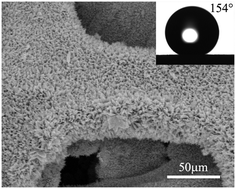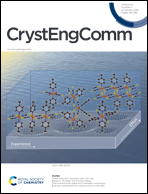Synthesis of superhydrophobic flower-like ZnO on nickel foam†
Abstract
Hydrophilicity greatly limits the application of ZnO in catalysis, sensing, energy conversion and other applications. There is an extremely urgent need to prepare superhydrophobic ZnO. In this study, a novel superhydrophobic ZnO flower-like nanostructure with petals 10 μm in length and 2 μm in width was obtained by a combination of hydrothermal and single dip-coating methods on nickel foam. Porous flower-like ZnO nanostructures were synthesized on the nickel foam substrate by an economical hydrothermal method combined with subsequent calcinations. The rough surface caused by acid treatment and the cross-growth of the petals increased the stability of the flower-like ZnO and the binding force between the ZnO layer and the nickel wire. Decomposition of the ZnO precursor released CO2 and H2O, leaving uniform holes in the ZnO petals. After hydrophobic treatment with PFAS, the contact angle was 154° and the sliding angle was approximately 2°, indicating that the surface changed from hydrophilic to superhydrophobic. The superhydrophobic surface could withstand a temperature of 350 °C in an air atmosphere, indicating that the superhydrophobic surface has good thermal stability. The ZnO flower-like nanostructure can be potentially used in microwave absorption, electrochemical sensing, heterogeneous catalysis and lithium-metal batteries. This work provides a new method for the practical fabrication of superhydrophobic surfaces.



 Please wait while we load your content...
Please wait while we load your content...